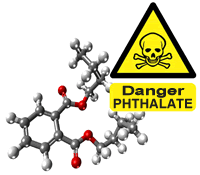
What is Phthalate ?
Phthalates are manufactured by reacting phthalic anhydride with alcohol(s) that range from methanol and ethanol up to tridecyl alcohol, either as a straight chain or with some branching. They are used primarily to soften polyvinyl chloride and usually used to extend the flexibility of plastics. They have low resolution in water, high resolution in oil. And they have carcinogenic properties.
Phthalates are used in a large variety of products, from enteric coatings of pharmaceutical pills and nutritional supplements to viscosity control agents, gelling agents, film formers, stabilizers, dispersants, lubricants, binders, emulsifying agents, and suspending agents. End-applications include adhesives and glues, agricultural adjuvants, building materials, personal-care products, medical devices, detergents and surfactants, packaging, children's toys, modelling clay, waxes, paints, printing inks and coatings, pharmaceuticals, food products, and textiles. Phthalates are also frequently used in soft plastic fishing lures, caulk, paint pigments. Phthalates are used in a variety of household applications such as shower curtains, vinyl upholstery, adhesives, floor tiles, food containers and wrappers, and cleaning materials. Personal-care items containing phthalates include perfume, eye shadow, moisturizer, nail polish, liquid soap, and hair spray [2].
Phthalates and Health
Phthalates are used in products such as; vinyl and plastic cups, food packages, house belongings, soaps, lotions and many body care products. Most known Phthalate DEHP Di(2-ethylhexyl) phthalate can cause cancer on humans accepted by IARC (Internatıonal Agency For Research on Cancer) [3]. Some types of Phthalates are known to effect kidney and liver [4]. According to researches; two most dangerous known Phthalates are (DEHP and DBP) mostly exposed by food. Foods are exposed to Phthalates by their PVC packages. Researches also admit that Phthalates can cause genital disorders and infertility [4]. Because of Phthalates are used in condoms, both men and women can be exposed. According to the analysis by Greenpeace, %40 of the toys and teether products for babies contain harmful Phthalates [5]. For that reason many toys and children’s products which include Phthalates, are banned in most of the European countries. EN 14372 [6] standard exists for toys. Besides that the amount of Phthalates are evaluated within REACH. Phthalates in toys produced in our country, is covered by Regulation on Restrictions for Preparations and Goods Production, Supply and Use on the Market of Certain Hazardous Substances [7]. It is reported that Phthalte used cannot be more than 0,1 % of the weight of the product. It is obligatory that Phthalate types in some products be analyzed and comply with legal limits, according to the statements of Notification Relating to the Market Surveillance and Control Against the Content of Some Hazardous Chemical Substances in Consumer Products [8].
| General Name of Chemical |
CAS NO | Name of Chemical |
Limit | Products Tested |
| PHTHALATES | 117-81-7 | Di(2-ethylhexyl) phthalate (DEHP) | % 0.1 (by Mass) |
-Childcare equipment -Pens and notebooks (plastic parts), eraser, glue, scissors, pencil sharpener, ruler, duct tape, tape, post-it, correcting tape and correcting fluid -Crayons and painting products (except play dough and finger paints) -Lunch box, school bag, backpack, painting bag, pencil case -Imitation food products -Products to help swimming -GYM mats, sunbeds, seabeds etc.. -Plastic prints and accessories on textile products -Raincoats, sneakers, slippers |
| 84-74-2 | Di-n-butyl phthalate (DBP) | |||
| 85-68-7 | Butyl benzyl phthalate (BBP) | |||
| 28553-12-0 and 68515-48-0 |
Diisononyl phthalate (DINP) | |||
| 26761-40-0 and 68515-49-1 |
Diisodecyl phthalate (DIDP) | |||
| 117-84-0 | Di(n-octyl) phthalate (DNOP) |
Conclusion
It is a high probability that many types of Phthalates exist in the products we are using in our daily lives. Depending on the types of Phthalates, it can be volatile or can be inhaled. Exposure to Phthalates can cause many health problems such as cancer, infertility, liver and kidney diseases, early puberty, asthma, respiratory problems, hormonal disorders and birth abnormalities. According to some researchers, Phthalates combined with other chemicals can cause worse health problems. To prevent these effects, one should be aware of the products on Table-1 and not to buy unreliable brands and products. Because of the exposure to Phitalates are most effective on children, we should be more careful about the products we buy for them.
Resources
[1] Phthalate, Wikipedia Free Encyclopedia, http://en.wikipedia.org/wiki/Phthalate, Access Date:14.06.2012
[2] Bradbury J., UK panics over phthalates in babymilk formulae. Lancet 1996; 347: 1541.
[3] IARC, http://monographs.iarc.fr/ENG/Monographs/vol77/mono77-6.pdf, Access Date:14.06.2012
[4] Chan PKL, Meek ME. 1994. Di-n-butyl phthalate: Evaluation of risks to health from environmental exposure in Canada. J Environ Sci Health C Environ Carcinog Ecotoxicol Rev 12(2):257-268.
[5] Ruth Stringer, Paul Johnston & Bea Erry, Greenpeace Research Laboratories, University of Exeter, 2001. Toxic chemicals in a child’s world: an investigation into PVC plastic products. http://www.bvsde.paho.org/bvstox/i/fulltext/child/child.pdf, Access Date:14.06.2012
[6] EN 14372, Child use and care articles - Cutlery and feeding utensils -Safety requirements and tests, http://www.ce-inc.org/picture/17594671676.pdf, Access Date: 14.06.2012
[7] Bazı Tehlikeli Maddelerin, Müstahzarların ve Eşyaların Üretimine, Piyasaya Arzına ve Kullanımına İlişkin Kısıtlamalar Hakkında Yönetmelik, Official Gazette Date: 26.12.2008 Official Gazette Number: 27092 Mükerrer.
[8] Bazı Tüketici Ürünlerinin Tehlikeli Kimyasal Madde İçeriğine Yönelik Piyasa Gözetimi ve Denetimine İlişkin Tebliğ, Official Gazette Date: 02.04.2011 Official Gazette Number: 27893.
[9] Phthalates in school supplies, http://copublications.greenfacts.org/en/phthalates-school-supplies/, Access Date:15.06.2012
[10] http://www.foodconsumer.org/newsite/Nutrition/Food/girls_puberty_1008100921.html, Access Date:15.06.2012
[11] Waring, RH & Harris, RM, Endocrine disrupters – a threat to women's health?, Maturitas, 68, 111-115, 2011.



